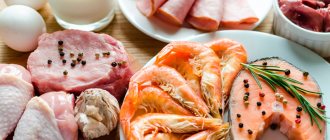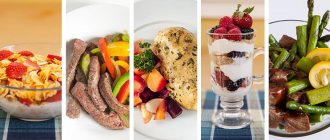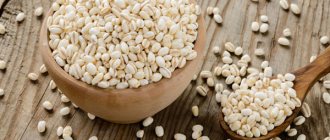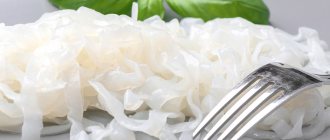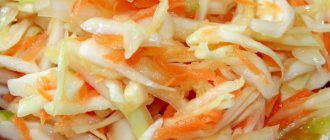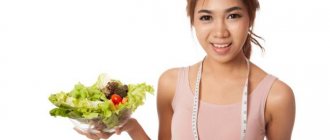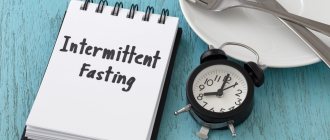This article was prepared by our beloved partners - the #GMfood - an online store of superfoods and craft eco-products.
Just for registering in the store you will receive 300 rubles to your personal bonus account and 2 more interesting gifts (Grab your gifts here)In the store's assortment you will find not only superfoods, but also healthy sweets, breakfasts, herbal teas, peanut butter, master classes for body health and facial beauty, and this is only a small part of the goodies and benefits!
Subscribe to Instagram #GMfood using this link and regularly receive new PP recipes with superfoods, see useful guides to the world of proper nutrition, and also look for gifts hidden under the link in the profile!
Menu for weight loss
Menu for weight loss - this topic is relevant for many women who want to lose weight. Who doesn't want to look good and have a slim figure?
You don't have to go on an expensive diet to do this. To be slim, just follow simple rules:
- Eat at the same time every day. Have breakfast before 9 am, lunch before 2, dinner before 7. This will improve metabolism;
- You need to eat right. The feeling of fullness occurs 20 minutes after eating. Therefore, you need to leave the table feeling a slight feeling of hunger. Food must be chewed thoroughly;
- Don't snack on sweets. Better eat an apple or a piece of dark chocolate.
The cheapest diet is a water diet, but it is not suitable for everyone.
There are many options for inexpensive diets for weight loss. They give preference to seasonal vegetables and fruits, cereals and lean meats.
Dessert
Curd casserole in the microwave
- curd mass - 249 g;
- egg – 2 pcs.;
- sweetener - 2 tbsp. l.;
- pear – 1 pc.;
- banana – 2 pcs.
- Beat eggs and cottage cheese.
- Add sweetener to the resulting mass.
- Cut the fruit into cubes and add to the curd mixture.
- Place the dish in the microwave for 3 minutes. With a power of 750 watts.
Banana and pear can be replaced with other fruits and vegetables. If the microwave power is less than 750 watts, the cooking time can be extended.
Raffaello PP
- grapes - 15 berries;
- soft cottage cheese – 99 g;
- protein – 51 g;
- ground cashew nut – 70 g.
- Mix cottage cheese and protein. But not in a blender. The mixture should be slightly liquid.
- Dip each grape into the curd mixture.
- Roll the resulting balls in ground cashews.
- Let the candies sit in the refrigerator for 20 minutes.
The PP menu compiled for a week for weight loss can be varied and useful. Any recipe can be suitable if you replace prohibited products with permitted ones.
The main thing to remember is that losing weight is an individual process, and PP is not just a diet, but a new way of life.
Article design: Mila Friedan
How to lose weight effectively
In order to lose weight, it is not at all necessary to go on strict diets and count calories. The easiest way to lose weight is to get rid of bad eating habits.
By eating healthy foods every day and following certain rules, you can achieve excellent results.
What are these rules?
- Eat no later than 18:00. All products that enter the body after this time are stored as fat;
- Eat 4 times a day. If food enters the body often and in small portions, it is much easier for the body to digest and absorb it. The optimal time between meals is 3 – 3.5 hours;
- You should only sit down at the table if you are hungry. Don't overeat;
- Do not cook food with vegetable oil or butter. It is better to boil or stew, this way the beneficial properties of the products are better preserved;
- Normalize your drinking regime. Drink 1.5 – 2 liters of fluid per day;
- Eliminate all cereals from your diet, leave only buckwheat, oatmeal and pearl barley. Avoid alcohol, fatty and spicy foods;
- If you want to eat in the evening before going to bed, you can drink a glass of kefir or eat low-fat cottage cheese.
Diet for losing weight
Proper nutrition - in the fight against excess weight
The menu discussed above is truly universal, as it can be organized to maintain body weight, to lose it, and even to build muscle. To use this diet for weight loss, it is enough:
- Reduce its calorie content to 1,600-2,200 calories.
- Break up meals up to 6-8 times a day.
- Prepare all dishes only by steaming, boiling or baking.
- Drink 2.8-3.5 liters of fluid daily (preferably green tea and water).
- Limit your sugar intake as much as possible.
- Consume any sweets, cookies and baked goods in very small quantities.
- Additionally, exercise (at least light exercise to speed up metabolism and speed up the process of losing weight).
Adhering to these principles, the optimal menu for maintaining weight can be easily converted into a diet for losing weight. As practice and people's reviews show, the effect of such a diet is quite significant.
Simple menu for weight loss
In this case, there is no need to eat on time and count calories. You just need to drink 2 liters of clean water a day and observe fasting and regular days, which must be alternated.
Extra pounds will go away due to the lack of carbohydrates in the diet, and you can eat fatty and salty foods. It is necessary to exclude ketchup and mayonnaise from the diet.
Carbohydrates are an integral component of the cells and tissues of all living organisms, representatives of the plant and animal world.
Source Wikipedia
Weight loss menu for a regular day
Breakfast : 2 soft-boiled eggs and salad with cucumber and celery.
Lunch : Fried skinless chicken drumstick; a piece of ham; cabbage salad.
Afternoon snack : A piece of cheese, a handful of nuts.
Dinner : 200 g of stewed meat, scrambled eggs with tomato.
Shortly before bed : Kefir, medium-fat cottage cheese.
Weight loss menu for fasting day
Breakfast: Baked chicken, rice, fruit and vegetable smoothie.
Lunch: Macaroni and cheese, vegetable salad, juice.
Dinner : buckwheat, boiled fish, yogurt.
Before bed : Orange, low-fat cottage cheese.
Fats in the diet
Fats
- an equally important class of organic compounds. First of all, it is the basis of cell membranes - that selective boundary that separates the contents of the cytoplasm from the extracellular fluid. In addition, it is also a substrate for the formation of sex hormones, adrenal hormones, and vitamin D.
Limiting their intake into the body or strict elimination is fraught with endocrine disorders and failure in the synthesis of many biologically active substances, and this is also one of the most common nutritional causes of an irregular menstrual cycle.
Lipids
- not only a kind of safety cushion, but also a substrate for energy production - although cells use them less willingly compared to glucose.
By analogy with proteins, a balanced diet requires the presence of both vegetable and animal fats - but the breakdown of both the first and the second with subsequent absorption requires the normal functioning of the gallbladder, which ensures the entry of an emulsifier into the intestinal lumen - bile, which also activates pancreatic enzymes.
Sources of high-quality, healthy fats are:
- Avocado.
- Fatty fish.
- Cod liver.
- Olives.
- Nuts and seeds.
- Many oils:
- creamy and baked;
- coconut;
- olive;
- avocado oil
Omega-3 polyunsaturated fatty acids also deserve special mention.
, suppressing the formation of pro-inflammatory molecules by influencing various signaling pathways, as well as improving the functioning of the internal lining of blood vessels - the endothelium (in particular, suppressing platelet adhesion, which subsequently leads to narrowing or complete blockage of the capillary lumen) and involved in the regulation of genes involved in lipid metabolism. In general, their long-term use is associated, as research shows, with:
- a significant decrease in the concentration of “bad” cholesterol (atherogenic - in the composition of LDL and VLDL);
- decreased formation of triglycerides in liver cells;
- stimulation of oxidation of fatty acids in mitochondria;
- preventing the development and progression of atherosclerosis;
- increased tone of the parasympathetic system;
- prevention of arrhythmias.
Study
: Omega-3 fish oil and omega-3 fatty acids in the prevention of cardiovascular diseases: myth or reality?
According to the UN Food and Agriculture Organization
) the amount of basic omega-3 fatty acids (eicosapentaenoic and docosahexaenoic acids - EPA and DHA, respectively) should be:
| 0-6 months : | DHA (0.1-0.18% E, where E is energy) |
| 6-24 months : | DHA (10-12 mg/kg body weight) |
| 2-4 years : | EPA + DHA (100-150 mg) |
| 4-6 years : | EPA + DHA (150-200 mg) |
| 6-10 years : | EPA + DHA (200-250 mg) |
| During pregnancy and breastfeeding : | 0.3 g/day |
Study
: GOED recommendations for EPA and DHA
Diet menu for every day
I offer a sample healthy nutrition menu for the week:
Monday
For breakfast : Oatmeal, boiled in water, 1 banana, 1 tsp. honey, green tea without sugar.
2nd breakfast – 1 apple.
For lunch : Vegetable salad, beetroot soup with beef and sour cream, a slice of rye bread.
Afternoon snack – 1 boiled egg.
Dinner : Chicken breast with spices, fried in a pan without oil.
Tuesday
For breakfast: Buckwheat, kefir, 1 egg, tea with honey.
2nd breakfast – 1 banana.
For lunch : Chicken sausages, buckwheat noodles, sugar-free compote.
Afternoon snack – casserole with cabbage.
Dinner: Steamed pollock, boiled beet salad with garlic and sour cream.
Wednesday
For breakfast : Cottage cheese casserole, a piece of cheese, tea without sugar.
2nd breakfast – 10 pieces of walnuts.
For lunch: Steamed meatballs, vegetable stew, bread.
Afternoon snack – 1 glass of kefir.
Dinner: Fresh vegetable salad, lazy cabbage rolls.
Thursday
Fasting day. During the day you can only drink kefir. There are only apples or buckwheat, you can have cottage cheese.
Friday
For breakfast : Oatmeal with cinnamon and honey, 1 banana, tea without sugar.
2nd breakfast – 1 apple.
For lunch : Pink salmon fried in a frying pan without fat, brown rice, fruit drink without sugar.
Afternoon snack – omelet.
Dinner : Cucumber, radish and egg salad, boiled chicken breast.
Saturday
For breakfast : Barley porridge with honey, tea without sugar.
2nd breakfast – fresh cabbage salad with apples.
For lunch : Buckwheat soup with chicken, Compote without sugar.
Afternoon snack – Cottage cheese with sour cream.
Dinner : Stewed pumpkin with beef.
Sunday
For breakfast: Sandwich with cheese, corn porridge, tea without sugar.
2nd breakfast – Zucchini pancakes.
For lunch : Stewed cabbage with chicken, baked potatoes.
Afternoon snack - jellied meat.
Dinner : Cottage cheese casserole with sour cream.
In order for the body to receive the required amount of vitamins and healthy fats, you need to consume 1 tbsp in the morning on an empty stomach. l. linseed oil.
List of “correct” products
Table of proper nutrition for every day
The concept of “the right product” is an extremely ambiguous definition. In general, it should be understood as all types of food that will be beneficial to the body and will not cause harm to it when consumed.
Such products fully include:
- greens rich in fiber;
- vegetables;
- fruits;
- berries;
- meat;
- fish;
- seafood;
- cereals;
- milk products;
- green tea and some types of black;
- compotes and fruit drinks.
All other products cannot be classified as correct and healthy. Taking them may be harmless, but it must be organized in a dosed and adequate manner.
In addition to the type of food itself, the technology of its preparation should be taken into account. The most useful and correct option would be to eat dishes prepared by boiling, steaming or baking.
You can eat fried, smoked and pickled products, but it is important to do this with extreme caution and always without abuse.
Proper nutrition for weight loss
In order to lose weight, you need to choose the right diet, that is, a minimum of fats and carbohydrates. Eliminate salty and sweet foods from your diet. But, if you return to your normal diet, the extra pounds will quickly return.
Proper nutrition includes 2 basic principles:
- Meals should be fractional and in small portions;
- The menu must comply with the rules of the KBZHU.
Doctor says
Anastasia Mertsalova
The combined opinion of doctors on this issue
KBJU is the ratio of proteins, carbohydrates, calories, fats that enter the body with food. K - means calories, B - proteins, F - fats, Y - carbohydrates.
Proper nutrition and diet are completely different ways to achieve weight loss results. On a diet, a person has to limit himself to certain foods. Often, when preparing a balanced diet, the individual characteristics of those who are losing weight are not taken into account. As a result, heartburn, diarrhea, and flatulence may occur.
Usually the effect of a diet lasts until it ends, sometimes a little longer. And after finishing the diet, the person stops losing weight and gains excess weight again.
If your goal is not temporary weight loss, but improving your health, then you need to choose the right diet. And understand for yourself that PP is not temporary weight loss, but a way of life.
Proper nutrition menu for weight loss
The basis of the PP menu for weight loss are the following products:
- For breakfast you should eat slow carbohydrates and protein: porridge, cottage cheese, eggs;
- 2nd breakfast should include fiber and protein: vegetables, fruits, eggs, cottage cheese;
- Lunch – protein, fiber and slow carbohydrates: vegetables, fish, boiled meat, porridge;
- Afternoon snack – protein and fiber: fruits, cottage cheese;
- Dinner - fiber and protein: baked meat, fish, fresh and steamed vegetables.
Proper nutrition: weight loss menu for every day
To achieve positive results when losing weight, you need to create the right menu in advance. It is necessary that the products are normal.
Monday
For breakfast: 50 g millet, 1 tsp. butter, 0.5 liters of kefir.
2nd breakfast : 150 g cottage cheese, 1 apple.
For lunch : 50 g of boiled buckwheat, 150 g of baked beef, 100 g of fresh cabbage salad, a glass of vegetable juice.
Afternoon snack : 1 boiled egg, 100 g of green peas.
Dinner : 150 g steamed fish, 100 g broccoli, black tea.
Tuesday
For breakfast: 50 g oatmeal, 1 tsp. olive oil, 200 ml yogurt, fruit juice.
2nd breakfast: 1 glass of milk, 1 banana.
For lunch: 150 g chicken breast, 50 g rice, 1 fresh cucumber, jelly.
Afternoon snack : One egg omelette, 100 g of corn.
Dinner : 150 g of steamed meat, 150 g of mixed vegetables, tomato juice.
Wednesday
For breakfast : 50 g oatmeal, 1 tsp. butter, 150 g cottage cheese, green tea.
2nd breakfast : 5 pcs. dates, 150 g natural yoghurt.
For lunch : 50 g buckwheat, 150 g baked turkey, 1 tomato, oatmeal jelly.
Afternoon snack : 1 glass of milk, 50 g of nuts.
Dinner: 150 g canned tuna, 150 g stewed cabbage, green tea.
Thursday
For breakfast: 50 g buckwheat, 1 tsp. butter, sandwich with butter from Borodino bread, 2 tsp. honey, tea.
2nd breakfast: Fruit salad with 200 g of yogurt.
For lunch: 50 g of rice, 200 g of chicken stewed with vegetables, beet salad dressed with olive oil, oatmeal jelly.
Afternoon snack: 1 glass of milk, 1 banana.
Dinner : Omelette of 2 eggs, 1 fresh cucumber, compote.
Friday
For breakfast : 50 g oatmeal, 1 tbsp. l. butter, 2 boiled eggs, black tea.
2nd breakfast: 1 glass of kefir, 5 pcs. prunes
For lunch: 50 g of millet, 2 steamed fish cutlets, 100 g of green peas, jelly.
Afternoon snack: 1 glass of yogurt, 100 g blueberries.
Dinner: 200 g of boiled veal, 100 g of stewed vegetables, green tea.
Saturday
For breakfast: 50 g buckwheat, 1 tsp. olive oil, 1 toast with honey, black tea.
2nd breakfast: 1 glass of milk, 10 pcs. dried apricots.
For lunch : 50 g of rice, 150 g of turkey baked with low-fat cheese and herbs, compote.
Afternoon snack : 1 banana; 50 g nuts.
Dinner: 150 g of boiled fish, 150 g of corn, green tea.
Sunday
For breakfast : 50 g oatmeal, 1 tsp. butter, 150 g cottage cheese, jelly.
2nd breakfast : 200 g milk jelly with fruit.
For lunch : 50 g rice, 1 tsp. butter, 200 g stewed beef with vegetables, compote.
Afternoon snack : One egg omelette, 1 tomato.
Dinner : 200 g baked turkey, 150 g fresh cabbage salad with dill, green tea.
The amount of cereal in the menu is indicated in dry form.
Inexpensive PP recipes
There are many inexpensive pp recipes that you can include in your diet while losing weight.
Dietary chicken soufflé
One of the most popular and favorite recipes on the budget pp menu is chicken soufflé. Chicken is rich in protein, which is so necessary for proper nutrition, but it is inexpensive.
To prepare a dietary soufflé you will need:
- 2 chicken fillets. You can also use minced chicken, but make sure it is fat-free and made entirely from sirloin. If you have breasts, then cut them into pieces and pass them through a meat grinder.
- 2 eggs. Separate the whites from the yolks.
- 200 grams of milk. Use skim milk.
Add half the milk, two yolks, salt and pepper to the minced chicken. Stir everything thoroughly. Now beat the whites to white peaks. Add the remaining milk to the minced meat and only then gradually add the proteins. Transfer the soufflé into a mold and cook in a slow cooker or double boiler for 40-50 minutes.
Dietary PP borscht
It’s hard to imagine an economy menu without dietary borscht. This dish perfectly satisfies hunger and is an ideal lunch.
- 300 grams of white cabbage. Finely chop
- 150 grams of beets and 100 grams of carrots. Cut into thin strips or grate.
- 1 small onion. Finely chop.
- 50 grams of tomato paste. Use natural, without adding various additives.
- 1 chicken fillet.
- Salt and pepper to taste
- 1 tablespoon vegetable oil
Pour vegetable oil into the bottom of the pan, add onions, carrots and beets. Fry a little, then add a little water and simmer for a couple of minutes. After that, add tomato paste and let it simmer for another couple of minutes. Then pour in 1 liter of boiling water and add cabbage and diced chicken fillet. Salt, pepper, cook until fully cooked.
Diet stewed cabbage with chicken
The ideal dish for the economy menu is cabbage. This vegetable is available at any time of the year and is inexpensive.
- 500 grams of white cabbage. Wash the cabbage and chop it
- 1 carrot. Grate
- 1 onion. Shred
- 1 chicken fillet. Wash and cut into small cubes
- 2 tablespoons of natural tomato paste.
- 1 tablespoon vegetable oil
It is better to cook cabbage in a slow cooker. Set the “Baking” mode, pour out the oil and add chicken fillet. Fry, then add onions and carrots to it. Cook for a couple more minutes. Add tomato paste, mix everything and simmer for a couple of minutes. At the very end, add the cabbage, salt and pepper, and switch the multicooker to the “Stew” mode.
Oatmeal pancake
One of the best breakfast options on the economy menu is oatmeal pancake. The ingredients for such a dish are always at hand, and the cooking process takes only a couple of minutes.
- 3 tablespoons oatmeal. Avoid using instant cereal.
- 1 egg
- 40 ml milk. You can use 1% skim milk.
Mix all the ingredients and bake the pancake in a non-stick pan. If desired, you can add vegetables or chicken.
Economical menu for a week for quick weight loss
The menu was compiled by a nutritionist.
Monday
Breakfast 8.00: 150 g 5 – 9% cottage cheese; 200 g kefir.
Snack 11.00: Natural yogurt without sugar or 200 g of kefir.
Lunch 14.00: 200 g vegetable soup with green vegetables without potatoes; 150 g chicken cutlets; 150 g of vegetable salad, preferably green vegetables.
Afternoon snack 17.00: Kefir – 200 g.
Dinner 19.00: 150 g lean meat, 160 g vegetable salad.
Tuesday
Breakfast 8.00: 250 g omelette with vegetables, tea.
Snack 11.00: Natural yogurt without sugar or 200 g of kefir.
Lunch 14.00: 200 g of vegetable soup without potatoes, preferably green vegetables; 150 g chicken cutlets; 140 g of vegetable salad, preferably from green vegetables.
Afternoon snack 17.00: 200 g of kefir.
Dinner 19.00: 150 g of lean meat, 160 g of green vegetable salad.
Wednesday
Breakfast 8.00: 180 g 5 – 9% cottage cheese, kefir – 200 g.
Snack 11.00: Natural yogurt without sugar or 200 g of kefir.
Lunch 14.00: 200 g okroshka on kefir without potatoes, 140 g stewed lean meat.
Afternoon snack 17.00: 200 g of yogurt without additives.
Dinner 19.00: 180 g of lean fish, Green vegetable salad – 160 g.
Thursday
Breakfast 8.00: Oatmeal; 3 dried fruits; An apple or a glass of natural apple juice.
Snack 11.00: 300 g of fruit (this is one large apple, preferably green), except bananas and grapes.
Lunch 14.00: Okroshka on kefir without potatoes – 200 g; 200 g stewed potatoes with mushrooms; 160 g vegetable salad.
Afternoon snack 17.00: 300 g of fruit, except banana and grapes.
Dinner 19.00: 190 g of rice with vegetables, 170 g of squash caviar, you can take store-bought.
Friday
Breakfast 8.00: Oatmeal; 150 g kefir; 3 dried fruits.
Snack 11.00: 250 g of fruit, except bananas and grapes.
Lunch 14.00: 250 g of borscht without potatoes, you can add 1 tbsp to it. l. sour cream; A piece of bread, preferably unleavened or whole grain; 200 g lean meat meatballs.
Afternoon snack 17.00: 200 g of kefir.
Dinner 19.00: 150 g of baked fish, 160 g of squash caviar or stewed vegetables.
Saturday
Breakfast 8.00: 250 g omelette with vegetables.
Snack 11.00: Coffee or tea, 50 g of hard cheese.
Lunch 14.00: Soup with meatballs from lean meat – 200 g; 200 g low-fat baked fish; Chinese cabbage salad with cucumber and one egg – 140 g.
Afternoon snack 17.00: 250 g of kefir.
Dinner 19.00: 170 g of lean baked or stewed meat, 150 g of stewed vegetables.
Sunday
Breakfast 8.00: 200 g kefir, 150 g cottage cheese.
Snack 11.00: Coffee or tea, 50 g of hard cheese.
Lunch 14.00: Soup with meatballs from lean meat – 200 g; Low-fat baked fish – 200 g; Chinese cabbage salad with one cucumber and egg – 140 g.
Afternoon snack 17.00: 250 g of kefir.
Dinner 19.00: 170 g of lean baked or stewed meat.
Second courses
Baked salmon with vegetables
- salmon – 450 g;
- broccoli – 450g;
- mixture of lemon juice and Japanese sauce - 4 tbsp. l.
A dish of salmon or any red fish would be ideal on the menu for the week.
- Remove bones from fish, rinse and dry with paper towel. Place in a convenient container and sprinkle with lemon juice and soy sauce. Leave to marinate in the refrigerator for 30 minutes.
- Separate the broccoli florets and open them.
- Place marinated fish and broccoli on a baking sheet.
- Bake in the oven at 201° for 25 minutes.
Meatballs with sour cream sauce
- Minced meat (chicken or turkey) – 399 g;
- ground ginger – 21 g;
- onion (chopped) – 201 g;
- carrots (chopped) – 99 g;
- garlic puree – 10 g;
- sour cream – 99 g.
- Add salt, spices, ginger and garlic to the minced meat. To stir thoroughly. Make small balls from the mixture.
- Lightly fry the meat balls in a dry frying pan.
- Fry the vegetables until golden brown. Add sour cream and a little water. Simmer a little more.
- Place the meatballs in a baking dish and pour sour cream sauce over them. Bake at 180° for 25 minutes.
Carbohydrates: quantity and types
Carbohydrates are primarily associated with energy - and they are indeed an almost universal fuel for the operation of cellular factories. In addition, they are also involved in the implementation of plastic and signaling functions - in other words, the body’s need for them is not inferior to the previously described proteins and fats.
They can be divided, depending on the chemical structure from which the rate of breakdown and assimilation follows, into simple
(typical representatives of which are glucose and fructose) and
complex
.
The former - the working bricks from which long, often branched hydrocarbon chains of the latter are built - actually immediately enter the systemic circulation: they do not need to be split - these are, in fact, structural units anyway. The speed of absorption also entails a sharp rise in the level of sugar (glucose) in the blood serum, causing a corresponding reaction from the pancreas.
Targeted nutrition tips
that will increase your energy level by 10 out of 10
From TOP nutritionists of the MIIN
Get tips
Sources of fast carbohydrates are
:
- candies, marshmallows, marmalade;
- white and brown sugar;
- semolina;
- corn flour;
- honey;
- sweet drinks;
- baked goods made from white flour;
- beets and potatoes;
- soda;
- White rice;
- sweet fruits.
Complex carbohydrates do not lead to such a “jump” in blood glucose: much more time and effort are spent on their enzymatic processing, which helps cut their heavy molecules into separate small fragments, and further absorption.
In addition, they also have a low or medium insulin index - in other words, they cause a much smoother secretion of this protein hormone. These are whole grain cereals, legumes, vegetables and berries.


